 Leading Blog | Posts by Month |
 Leading Blog | Posts by Month |
10.29.07

How To Get Great Ideas: Lessons for Brainstorming
IN 1941, advertising man Alex Osborn (BBDO) came up with the idea of “Thinking Up” which was later changed to brainstorming by his “thinking-up” colleagues. In an excellent book about innovative and productive thinking simply titled, Think Better, author Tim Hurson reviews Osborn’s list of four essential rules for effective brainstorming:
Hurson notes that studies have shown that the last third of a brainstorming session usually results in the best ideas. He calls it the miracle of the third third. “You’ll have a greater chance of coming up with that one brilliant idea if you get all the way to the third third than you will if you stop at the first “right” idea.” He writes: The first third of the session tends to produce mundane, every-one-has-thought-of-them-before ideas. These are the early thoughts that lie very close to the surface of our consciousness. They tend not to be new ideas at all but recollections of old ideas we’ve heard elsewhere. They are essentially reproductive thoughts. He says, “Brainstorming is like cholesterol—there’s good and bad, and most people have only experienced the bad.” We have all experienced brainstorming like this: There’s no separation of the different ideas of thinking going on. Creative, idea-generating thinking is being stopped cold by critical, judgmental think. Ideas are being killed before they’re fully articulated. He adds, that “Bad brainstorming is binary; ideas are either good or bad. Good brainstorming is full of maybes." The biggest issue we face in creative thinking is our own patterns of thought that keep us on the straight and narrow. We hold ourselves back because of personal notions of what is right and wrong and what will and won’t work. There’s no magic pill to conquer this. It takes a conscious effort. He suggests though that “Generating long lists of ideas flushes those early ideas out of your head so you can make room for new ones.” Tim Hurson is a founding partner of thinkx intellectual capital. It is a global consultancy for productive thinking and innovation. 
Posted by Michael McKinney at 10:53 AM
10.26.07

Is CEO the Job Right For You? Look Before You Leap The leap to CEO from any other position is a big one. Ram Charan writes, “The job of a CEO is more intellectually, socially, politically, and psychologically demanding than ever. And it is much more challenging than other jobs leading up to it.” The Wall Street Journal reported this week in A Different Animal Seeks the No. 1 Post; Often, It’s Not No. 2, that “the gap between No. 1 and No. 2 in a company is often bigger than many realize. CEOs not only perform different tasks from their second-in-commands—who typically focus on running operations—but they have to act differently too. That means the two roles often demand very different personality traits, say people who have been there.” WSJ author, Phred Dvorak, continues, “The very talents that make a great chief operating officer—like finicky attention to detail—can get in the way when you are in the top seat. CEOs are supposed to strategize, not micromanage.” Murray Martin, Pitney Bowes CEO, told Dvorak, “He can understand how executives with more retiring personalities wouldn’t like the transition. One of the biggest differences between the two jobs [COO/CEO] is how much time is spent on external affairs.” We have seen people taking positions in organizations across the board—business, politics, religion—who like the idea—the trappings—but can't handle the pressure and responsibility. They complain, “Why don't they just leave me alone?” But that’s part of the job. Perks only come with responsibility. The CEO job is certainly one where you need to count the cost as there is a dramatic shift in expectations, but any leadership position should be weighed before you accept it. Is CEO the job right for you?
Posted by Michael McKinney at 09:07 AM
10.24.07

Making Leadership Development Part of Organizational StrategyMichael Maccoby states in his book The Leaders We Need, that “In any business, good leadership may be the most essential competitive advantage a company can have.” Linking leadership and strategy then, would seem to be an organizational imperative.According to a recent study outlined in The Leadership Advantage by Robert Fulmer and Jared Bleak, leadership is the essential element in the success of any strategic change effort. “Indeed, no strategy is good enough to succeed without strong leadership.” They found that successful organizations built a strong link between business strategy and leadership-development strategy. The link between business strategy and leadership-development strategy is not haphazard, but specific and deliberate and omnipresent. The link is part of the philosophy of the organization that “permeates all organizational levels and is applicable to all employees.” In this way, an organization can keep the leadership-development strategy relevant to each business unit and to the overall business strategy in general. For example: PepsiCo’s leadership-development strategy is grounded in the belief that strong leaders are needed to be successful in the marketplace.Using senior executive to teach emerging leaders is an effective two-way street where both benefit. One of the surprising findings of this project was the degree to which senior executives practice the concept of leading by teaching. At PepsiCo, Paul Russell, vice president of executive learning & development, speaks of “the magic of leaders developing leaders.” According to Russell, the missing adult-learning principle is that “people learn best when they get to learn from someone they really want to learn from.” Russell notes that “at PepsiCo, the ‘teachers’ our executives want to learn from are our own senior leaders. They are world class, widely respected, and have proven that they can do it here!”
Posted by Michael McKinney at 08:26 AM
10.22.07

Never Complain. Never Explain.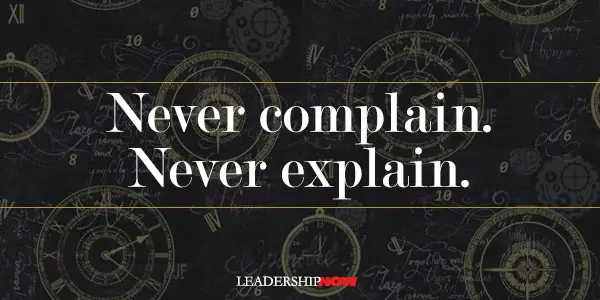
Christine Comaford-Lynch relates the following story in her book Rules for Renegades: There was once a monk who lived in a tiny hut on a hill overlooking a village. He kept to himself, only coming down to the village for food. In that village, a young woman had become visibly pregnant, and when her screaming father insisted on knowing who her lover was, she named the monk. An angry mob marched up the hill and stormed the monk’s hut. Whether people are praising you or trashing you, neither changes your intrinsic value. Don’t be easily swayed. It reminds me of a statement originally offered by prime minister Benjamin Disraeli, that Henry Ford II once famously said, "Never complain. Never explain." It's good advice. (Although, he probably meant it more as a corollary to the Fifth Amendment than good advice for leaders.) It speaks to accountability—personal accountability. “Never explain—your friends do not need it, and your enemies will not believe you anyway.” Although it gives your power to others, there are times to explain to obtain a positive resolution in a relationship. Explaining often draws you into conversations that are a complete waste of time. Silence is often your best friend. The Proverbs tell us, “When words abound, transgression is inevitable, but the one who restrains his words is wise.” Complaining is the outward expression of inner frustration. A complaint acknowledges that something is not as we think it should be. (And that may or may not be true. Quite often we lack all of the pertinent information.) The problem is that we often begin to complain as if that will lead to a solution. It rarely does. Complaining is outward focused and is a form of blaming. The issue is internal. If you can fix the problem, then you should quietly fix it. If you can’t, you should change your perspective on it and move on. Complainers generally have a lot to complain about because they are in fact, complainers. Complaining, explaining and excuse-making extend the time you are embroiled in the issue. It amplifies frustration—your own and others—spreads discontent and discord and generally makes you unpleasant. Jane Austin observed that "those who do not complain are never pitied." Pity, however, is not the goal of a well-adjusted person let alone a leader. Of more value is novelist Cesare Pavese comment that "one stops being a child when one realizes that telling one's troubles does not make things better." Recognize your part, take responsibility and move on.
Posted by Michael McKinney at 10:47 AM
10.19.07

The Impending Leadership Vacuum The study reports that the most vulnerable companies are those in the industrial sector and those operating in the Asia Pacific region. Yet the impending leadership crisis is a worldwide issue. Driving the problem is the retirement of baby boomers and rapid growth in Asia. Baby boomers will drain companies of valuable knowledge when they retire, while multinational firms need to find people to lead their businesses in booming markets such as India and China. The crisis doesn’t end there. “Not only are companies concerned with their current leadership capacity,” the study says, “they are confronted by their inability to develop future leadership talent. Over 75 percent of companies indicate building leadership talent is a significant challenge.” Fifty-two percent of the human resources executives interviewed said their organizations may be unable to rapidly develop skills to meet current or future business needs. The report concludes: Creating an adaptable workforce requires more than a series of HR programs….It requires the ability to identify experts and foster an environment where knowledge and experience travel beyond traditional organizational boundaries. It calls for a talent model that can help companies recruit, develop and retain valued segments of the employee population….The human resources organization, by itself, cannot be expected to shoulder this entire effort. True, the HR function needs to take a lead role in providing strategic guidance on workforce issues and designing human capital programs that can enhance workforce effectiveness. However, the entire executive suite needs to play a role in improving workforce performance. This may involve providing functional expertise, taking joint responsibility for executing human capital programs or simply setting a positive example for employees within their organizations. Without this unified commitment, all bets are off….The key to building that kind of workforce lies with the leadership of the organization, facilitated in large part by HR.The ideas in Ram Charan’s upcoming book, Leaders At All Levels, while focused more at developing CEOs specifically, addresses this looming issue and leadership development in general. He has developed a new approach to leadership development that moves it from just an HR function to “an everyday activity that is fully integrated into the fabric of the business and in which line leaders play a central role.” He calls it the Apprenticeship Model. It is essentially learning by doing. In this timely and valuable book, he states that we focus on the wrong people for the wrong reasons and thus we fail to recognize and develop emerging leaders. He constructed a guide to correctly identify leadership talent early-on, called the CEO Nucleus. We’ll take a closer look at what Charan has to say on this important issue as we approach the book’s December 21 release date.
Posted by Michael McKinney at 12:12 AM
10.17.07

The Teacher Can Only Be a Help or An Impediment To Learning
IN 1969, Peter Drucker published the leadership classic, The Age of Discontinuity: Guidelines to Our Changing Society. In a discussion on the crisis in education, he argues that we don’t need more money, we need better methodology. We need creativity to improve productivity in the classroom. Few teachers spend in their entire teaching careers as much time or thought on preparing their classes as in invested in the many months of writing, drawing, acting, filming, and editing one thirty-second commercial. [The commercial] is indeed the prototype of the ideal “program” with its three key elements: effective sequence of the material, validation through repetition, and self-motivation of the learner through pleasure. A level of teaching that was acceptable to older generations, who had no standards of comparison, dissatisfies the children of the television age, bores them, offends them. How well do your presentations, your training, meet these criteria? If we are boring people, they will stop learning. 
Posted by Michael McKinney at 09:10 AM
10.15.07

Teaching and Learning Are Not the Same Thing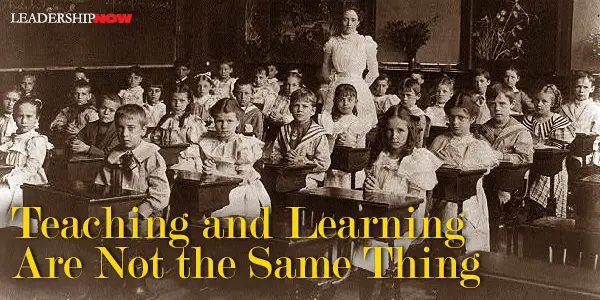
I don’t how often you have asked a teacher why they got into teaching, but all too often I hear, “Because I love kids.” Well, that’s a good reason to get into daycare, but hardly a good reason to get into teaching. It hardly surprising that our school boards think throwing money at the education problem will solve it. Teaching is a skill distinct from liking people or intellectual ability—although it’s good to possess both to be an effective teacher. Sadly, while teachers should be teaching (and many wish they were), too many find themselves babysitting. Make no mistake, this happens in the workplace too. Over 160 years ago, Horace Mann, American educator and founder of the first school for teacher education in the United States (1839), wrote, “The ability to acquire and the ability to impart are wholly different talents. The former may exist in the most liberal manner without the latter.” The ability to acquire is the power of understanding the subject manner of investigation. Aptness to teach involves the power of perceiving how far a scholar understands the subject matter to be learned, and what in the natural order, is the next step he is to take. It involves the power of discovering and of solving at the time the exact difficulty by which the learner is embarrassed. The removal of a slight impediment, the drawing aside of the thinnest veil which happens to divert his vision is worth more to him than volumes of lore on collateral subjects. In the workplace, as well, we would be wise to remember that teaching is an art that must be adapted to the students learning patterns and by those with an aptitude to teach. In both our schools and workplaces, we need to enable students to learn and teachers to teach. Next we will take a look at the thoughts that one of the most insightful thinkers of our time wrote on teaching, 128 years after Horace Mann.
Posted by Michael McKinney at 09:12 AM
10.12.07

Leading When Things Aren’t Going Your WayIn Bo’s Lasting Lessons, authors Bo Schembechler and John Bacon relate a story from Bo’s early days coaching. He learned a lesson about leading when the heat is on from his boss from his boss and mentor Ara Paraseghian that he carried with him the rest of his life. Here's that excerpt:The following season, 1956, I left Doyt [Perry] 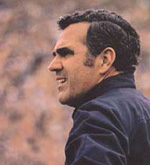 and Bowling Green—with his blessings—to become an assistant for Ara Parseghian at Northwestern University.
and Bowling Green—with his blessings—to become an assistant for Ara Parseghian at Northwestern University.
Ara was not a big ego guy, he was great with players, he was a wonderful motivator, and he understood the game so well he could come up with things no one else had thought of. He was probably the most imaginative coach I’d ever seen, always adapting his plays to his players instead of the other way around like most coaches do. Heck, we used to call his practice field “The Laboratory,” because that’s where he’d try every trick in the book on Mondays, testing this and experimenting with that, just to see what might work that Saturday. Before Ara arrived, Northwestern hadn’t had a winning season in five years, but in his first year Northwestern went 4-4-1, and everyone was encouraged. But in Ara’s second season, 1957, everything went to hell. We lost nine games—every single game we played! For a coach, that’s just about the most difficult situation you have to face. We could keep our opponents down to one or two touchdowns, but we couldn’t score for our lives. And I was working with the offense! Losing creates all kinds of other problems too—poor morale, nagging injuries, lackluster effort. The players were spending more time in the PR office than in the weight room. It was just a mess. I never experienced anything like that in all my years of coaching—and thank God for that. I learned an awful lot from Ara in my first year at Northwestern, but I learned a heckuva lot more from him that second season, when he lost ‘em all. And what I learned was how a real leader leads when things aren’t going his way. Ara treated the staff as though we were winning every game. He never gave the slightest inclination that we were the problem. He not once blamed any assistant or any player fro any loss we suffered that year. NOT ONCE. “Stick with it, guys, and we’ll get through this,” he’d tell us. “We’re going to be okay.” We all kept busting our butts for Ara, working past midnight, doing everything we could to get that guy a victory. I’m not saying there wasn’t some bitching among the players. When you’re losing every game, every player thinks he deserves more playing time. But I promise you this: There was a whole lot less bitching on that team than I’ve heard on teams that won half their games—and there was absolutely no, but no, bickering among the coaches. And that wasn’t even the most impressive thing Ara did that year. Stu Holcomb was Northwestern’s athletic director, and his son Chip was a backup quarterback on the varsity. In the middle of this losing streak, Stu kept cranking up the pressure for Ara to start his son. At one of our staff meetings, Ara laid the situation on the table. Then he asked us point-blank: “What do you think?” The thing is, there wasn’t anybody on the staff pounding on the table to make a quarterback change just because we were losing. We knew there had to be a ton of pressure on Ara to put Stu’s son in, but our quarterback wasn’t the problem. And that’s exactly what we told him when he asked us. He just nodded. Another coach—maybe most coaches—would have caved in to their boss just to save their hides. But Ara held firm. He didn’t change quarterbacks, or even consider doing it. And every one of us who walked out of the coaches room that day felt the same way I did: Ara Parseghian is a stand-up guy. He’s a leader. I want to work for this guy! And that’s why that losing season didn’t break Ara’s back: Because he’s a confident guy, and he knew he could coach. His staff remained dedicated to him and his program the entire season. You’d think my two years at Northwestern would have been a horrible experience, but it wasn’t. It was a great experience, because Ara had put together a stellar staff—they’re all still good friends of mine, especially Alex Agase—but mostly, it was because Ara was there. The result? Put this down: Ara Parseghian lost every game that year, but the next year his team went 5-4—Northwestern’s first winning season in eight years. When Ara took the Notre Dame job five years later, in 1963, he left Evanston as one of only three coaches in the last century of Northwestern football to post a winning record. And of course, from there he won two national titles and Coach of the Year at Notre Dame. Don’t tell me he didn’t deserve it. But that 0-9 year? He didn’t get any rewards for that, but let me tell you: THAT was the most impressive year of his coaching career.
Posted by Michael McKinney at 11:02 AM
10.10.07

Shogun Yoritomo-Tashi on Leading by Example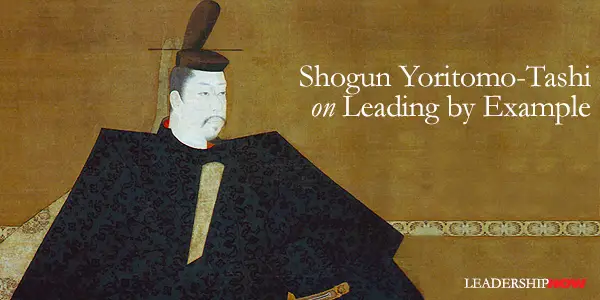
ANCIENT Shogun Yoritomo-Tashi believed that the art of influencing others was the key to success. The Japanese statesman and philosopher believed that the spirit of the individual continuously exerts influence, even as the flower also exerts influence by spreading its fragrances in the air. But just as the blossom can not tell whether its fragrance spreads, so none of us can say how far our influence may reach. From his writings we have his take on the dynamics of influence by example: The reciprocal influence which individuals exercise on one another is the cause of many evils difficult to conjure.… The influence of example is considerable. One of the greatest obstacles to the doing of good actions is the timidity based on the fear of responsibility, which haunts mediocre minds.
Posted by Michael McKinney at 08:51 AM
10.08.07

5 Leadership Lessons: Bo's Lasting Lessons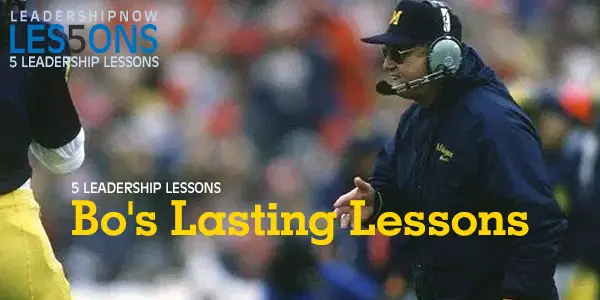
Bo Schembechler's book, Bo’s Lasting Lessons, written with John Bacon is an engaging, hands-on, first-person account of the winningest head coach in Michigan football history and fifth on the all-time list, only behind coaching legends Paul 'Bear' Bryant, Amos Alonzo Stagg, Glen 'Pop' Warner, and Woody Hayes. The lessons found here are easily applied anywhere.

Posted by Michael McKinney at 06:01 PM
10.07.07

Newswire: Why Teach Leadership
Posted by Michael McKinney at 08:46 AM
10.05.07

When is it Time to Move On? Managing Change is a one in a series of books from the Harvard Business School Press, that presents interviews with top leaders from various fields. In chapter 12 is one such interview with CEO of GenSpring Family Offices (formerly Asset Management Advisors), Maria E. "Mel" Lagomasino.
Managing Change is a one in a series of books from the Harvard Business School Press, that presents interviews with top leaders from various fields. In chapter 12 is one such interview with CEO of GenSpring Family Offices (formerly Asset Management Advisors), Maria E. "Mel" Lagomasino.
Faced with a new merger that would change the culture of the organization, Lagomasino, then chairman and CEO of JP Morgan Private Bank, had to make a tough decision to step down at the top of her game and move on. Here are some of her thoughts on the process: This is the toughest lesson, I think; after you devote yourself to a company and to a lifelong career, and you’ve been very successful—as I have been lucky enough to be—to be able to say, “We’ve come to the point where you need to step down.” This is the time when you have to know when to fold them. 
Posted by Michael McKinney at 12:04 AM
10.03.07

Holistic Leadership
For many leaders, running an organization has been distilled to a mundane pattern of meeting the numbers and the metrics every quarter, and this tends to be how the organization’s success and the skills of its management are defined. For many, it defines who we are. In The Little Prince, Antoine de Saint-Exupéry wrote: Grown-ups like numbers. When you tell them about a new friend, they never ask questions about what really matters. They never ask: “What does his voice sound like?” “What games does he like best?” “Does he collect butterflies?” They ask: “How old is he?” “How many brothers does he have?” “How much does he weigh?” “How much money does his father make?” Only then do they think they know him.Of course, running an organization—or any community of people for that matter—and being a responsible leader, requires us to pay attention to the numbers and to act prudently on the information revealed by the metrics. But we can grow our successes by consciously leading organizations with greater awareness of the importance of myth, mystery, and magic. That is what inspires the people who work there, because inspired people have a way of making their numbers. As conscious leaders, we become whole when we see that our focused, singular commitment to making the numbers and the metrics cannot be effective on its own, but only when it is part of the whole picture—only when we see that it takes more than metrics to make up the whole. Adapted from One: The Art and Practice of Conscious Leadership by Lance Secretan
Posted by Michael McKinney at 08:38 AM
10.01.07

Leadership Books: October 2007Here's a look at some of the best leadership books to be released in October.




Posted by Michael McKinney at 08:54 AM
|
BUILD YOUR KNOWLEDGE


How to Do Your Start-Up Right STRAIGHT TALK FOR START-UPS 
Grow Your Leadership Skills NEW AND UPCOMING LEADERSHIP BOOKS 
Leadership Minute BITE-SIZE CONCEPTS YOU CAN CHEW ON 
Classic Leadership Books BOOKS TO READ BEFORE YOU LEAD |
|